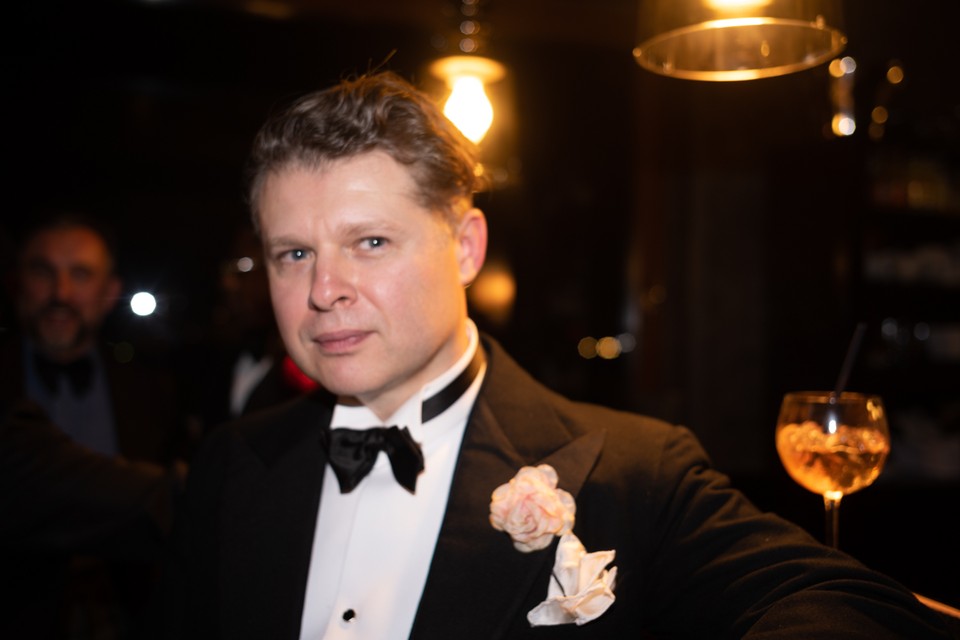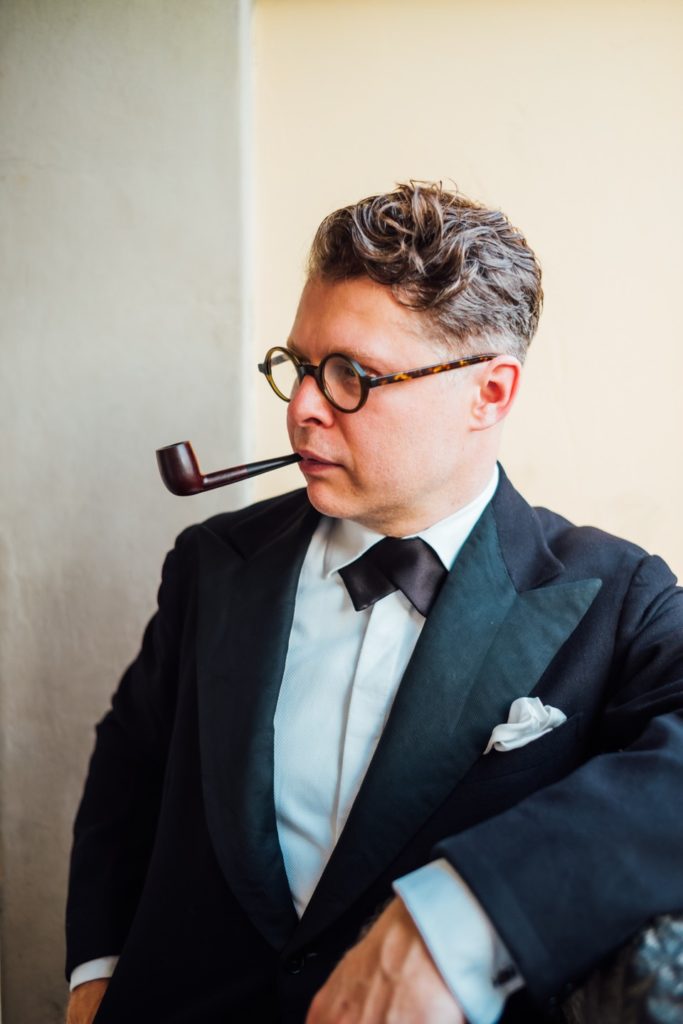
Mickael sat down with friend and long-term collaborator, photographer Hanson Leatherby who has followed Mickael around Florence at Pitti Uomo and in and around London at black tie events, capturing la Bowtique bow ties on a plethora of people.
Mickael: Please introduce yourself to our readers and customers who are familiar with your work for la Bowtique but might not know much about you…
Hanson: I’m a freelance photographer, I’ve been shooting freelance for over 10 years and before that, I did some assisting in fashion briefly for Rankin and then the guy that I mentioned today Mariano Vivanco. The naughty photographer. I felt like I didn’t want to take pictures of naked men so I stopped working for Mariano Vivanco. Rankin, after the second week of being his assistant, he got angry because I came back with a latte instead of a cappuccino and then he asked what my name was, even though I’d been there for two weeks, you’d know my name! So I thought this is really going well. So I decided to leave the world of fashion and the much poorer for it. I’m sure they all remembered when I left.
I do reportage and then some of my interests in artists in the sort of mid-century, 20th century. So incorporating an abstraction and also incorporating a sense of photojournalistic realism to my work.

Mickael: So mostly people and then mixing with your interest of dressing up?
Hanson: Yeah, yeah. clothing and instead of the non-clothing of the early days. Well, I yeah the vintage thing and clothing thing is and I suppose it’s just been allowed me to pursue a certain aesthetic that interests me and with the reenactment photography that I’ve done that’s given me a way to create, explore the idea of photojournalism without actually going out there and get my head blown off. You can pretend to be water and shoot with some of the older gear that I have, the more hands-on, simple equipment. I’ve been drawn to shooting with film because of its simplicity and organic look and also shooting in digital. Initially, I got a little bit put off with digital because of the look of it being a little bit sterile compared to film. So that’s why I moved to shooting Leica does give a sort of purism aspect to it without overloading you with all the technical gubbins of a digital camera and it still feels a bit more like film. Yeah, so that’s why I shoot Leica digital to feel that process is still alive, the film process is still alive.
Mickael: So what you’re describing is very similar to what I do, which is all quite, hopefully, quite natural and approachable and very personal. And I think since you’ve been shooting for us, you set the tone for the photography going forward. When do you think was the first shoot that we did together and you saw that’s a direction that we’re going to take and that works quite well with the image that I wanted to portray?
Hanson: I think that it was important to show you and your personality in the brand it being too faceless, so incorporating that idea that I have to extract something alive from a photograph, getting deep under someone’s skin a little bit, maybe revealing something that they may or may not like or might surprise them to an extent and trying to get that in there in some form. And then having a sense of dynamism or some form of unexpectedness to it. Within the energy of the person and within the consideration of composition. Thinking about how your eye rolls around within a frame. The thing is with Instagram you are quite limited when it comes to the Instagram format but I do try to incorporate as much of those thoughts as possible. I get inspired as well by the pioneering colour after the war because they were using colour slide film and colour slide film was seen as either a way to document things, I think the army was using it just as an extra level of information to capture stuff and then people started using them for holiday snaps but the creative photographers they looked down on colour film they always thought black and white was the art form of photography. But then there were a few people that started to use colour in a creative way and it’s very much like some of the photographers, they remind me of you know oil paintings or screen prints or the flatness of colour exploiting the limitations of early colour by making the most out of its idiosyncratic kind of colour tones that aren’t necessarily like real life. Yeah. But that makes it more painterly or more like an art form. So fixing the time. The likes of Sol Leiter and Ernst Haas were the two great colour photographers at Spring to Mine for me. They were printing from slide film and desaturating some of the work, playing around with the colours to give it a look that was more painterly. But I try and consider those ideas within photography as well, how I can do that. And specifically with black-tie photography, because that’s what you do with that, how do you manage to make it more approachable just so people can relate easily rather than having something very stiff which is how black tie is usually seen.
Well, you have to sell a lifestyle or an idea or make the viewer think that something is happening behind the scenes or it’s something that you can be a part of. Yeah. So shooting things that you do and making it feel real and glamorous and exciting and a bit edgy can draw people in. It shows you in a more raw form and not too staged, like it is a very sterile photoshoot that is too clean and that aspect of it allows people to come in because there’s no barrier there. So you’ve got the glamour side of it – you’ve got the interest of what’s going on behind the scenes and then you’ve got the journey into the personality that is, they can relate to a human rather than a model.
Mickael: There are a lot of pictures obviously of myself but there’s also people, other people involved in photoshoots. So it’s not only with me. So how do you manage to you know to find a natural side of people because you know a lot of your pictures are they’re quite lively there’s a lot of you know hand gestures and way like massive laughs or the eyes are going weird. So how do you tend to capture?
Hanson: I’m just permanently screwed up and twisted up in my mind waiting like some kind of mad hunter sitting there waiting for something to happen and when I’ve done it for so long, event photography I sort of anticipate the mood of a moment and see that something’s going to happen and I just wait for something either absurd or interesting or dynamic to happen within an image and I’m not afraid to get shots of people looking startled or… it doesn’t have to be about smiling, it can be about…
Mickael: Because it’s not about people looking their best, is it?
Hanson: No, not necessarily.
Mickael: That’s not what it is?
Hanson: It’s about a story. And life is so much more than just being happy. It’s about being confused, startled, drunk, hysterical, and everything in between. And that’s what gives it a depth you know it’s not just about grinning at the camera it’s about something deeper than that. I think people who are looking at it they see more and they want to see more if there’s more human expression in there. Yeah because we don’t do things that are product-oriented etc. It’s mostly parties really. What is there that you’d like to do more of? You know that are not parties that we could do
When you’re doing something that is has a beginning and an end and there’s a concept to it and you put the product within that concept rather than it just being a static idea. So more of a storyline? Yes, I mean for instance like when we were saying, you know, you get, where Black Time, go to the opera or something, and you shoot that event, and you have a few ideas of what you’re going to get but there’s enough material there to make unexpected things happen. And I quite like it when it has that aspect of realness to it. So you can get the reportage, funny moments or interesting moments if there is a story there. And that is natural as well. Yeah. It’s something actually happening yeah I like the idea of it having some realness in there yeah that that’s something like that on a smaller or larger scale. I like the idea of a story or the story in there. I think there’s a lot of photography in fashion and menswear, certainly in the mainstream, the ideas are not really there I think there’s a lot of photography in fashion and menswear, certainly in the mainstream, the ideas are not really there and the model.
